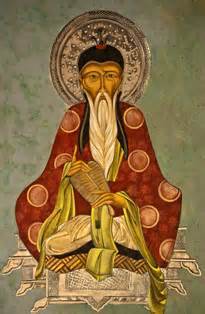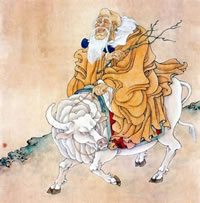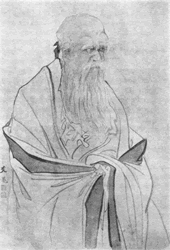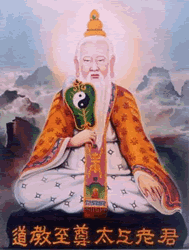Notes on the Display of the Chinese Characters in the Tao Te Ching by Lao Tzu
Research, Compilation and Indexing
of the Tao Te Ching by
Michael P. Garofalo
© Green Way Research, Valley Spirit Center,
Gushen Grove Notebooks, Red Bluff, California,
© 2015 CCA 4.0
Chapter 53, LIII, Tao Te Ching by Lao Tzu EXAMPLE
In the traditional written or printed display of the Chinese characters (ideographs) for this Chapter of the Tao Te Ching, Chapter 53, as shown above, the text is read starting from the far right hand column, beginning with the top character in the column 使 and reading down to the bottom character in that column 知. Then, you move to the second column in from the far right end column, and read downwards from the top character in the column 行 to the bottom character of the second column 道. Then continue reading the characters from the right hand columns towards the left hand columns, and from the top of each column to the bottom of each column. It is a vertical arrangement by columns, reading the columns sequentially from right to left, and from the top of each column to the bottom of each column.
Readers will observe that there are no punctuation marks in the written or printed Chinese text. In written or printed English we commonly use punctuation marks such as a period, comma, semicolon, colon, question mark, exclamation point, dash, etc.
Alternative Formatting of Chinese Characters on a Webpage
Another way of displaying the Chinese characters on a webpage or printed page, for a verse (Chapter) of the Tao Te Ching, in a typographical format familiar to readers of the English language is as shown below. It is a horizontal arrangement by lines, reading each line from left to right, and reading the Chapter (Verse) line by line from the top line to the bottom line.
Chapter 53, LIII, Tao Te Ching by Lao Tzu EXAMPLE
使我介然有知.
行於大道.
唯施是畏.
大道甚夷而民好徑.
朝甚除.
田甚蕪.
倉甚虛.
服文綵.
帶利劍.
厭飲食.
財貨有餘.
是謂盜夸.
非道也哉.
- Chinese characters, Tao Te Ching,
Chapter 53
Using the above format as the template, the Wade-Giles and Pinyin Romanized translations of the Mandrain spoken language words for the Chinese character are shown below. The display formatting corresponds to the line by line version of the Chinese characters shown above. Since only one word is given for each character, the Wade-Giles and Hanyu Pinyin Romanized (Latin script) transliterations are translations, interpretations, or versions of the possible meanings in the Mandarin Chinese spoken language as read from the Chinese characters. The Chinese characters may have multiple meanings in any spoken language.
The Chinese characters for each Chapter, and both a Wade-Giles and Hanyu Pinyin Romanized (i.e., Latin script) version of the Chapter are included on each of my 81 Daodejing webpages. The Wade-Giles method for using the Roman (Latin) script to represent the sounds of Mandarin Chinese words was developed in 1892, and the Hanyu Pinyin method of Romanization was standardized in 1982 in the People's Republic of China.
There is some variation in how the Chinese characters for a Chapter of the Tao Te Ching are arranged, ordered, punctuated, and presented on a webpage or printed text; so readers should consult the many excellent books and webpages cited on my webpages for alternative versions to my display of the Chinese characters and the corresponding line by line Wade-Giles and Pinyin Romanized translations.
Chapter 53, LIII, Tao Te Ching by Lao Tzu EXAMPLE
For example, Line 1: Chinese
Character, Wade-Giles Romanization of Mandarin Chinese word, Hanyu Pinyin Romanization
of the Mandarin Chinese word
使 (shih,
shi) 我
(wo, wo) 介
(chieh, jie) 然
(jan, ran) 有
(yu, you) 知
(chih, zhi)
Characters Wade-Giles or Hanyu Pinyin
使我介然有知.
shih wo chieh jan yu chih. or shi wo jie ran you zhi.
行於大道. hsing yü ta tao. or xing yu da dao.
唯施是畏. wei shih shih wei. or wei shi shi wei.
大道甚夷而民好徑.
ta tao shên yi erh min hao ching. or da dao shen yi er min hao jing.
朝甚除. chao shê ch'u.
or zhao shen chu.
田甚蕪. t'ien shên wu.
or tian shen wu.
倉甚虛. ts'ang shên hsü.
or cang shen xu.
服文綵. fu wên ts'ai.
or fu wen cai.
帶利劍. tai li chien.
or dai li jian.
厭飲食. yen yin shih.
or yan yin shi.
財貨有餘. ts'ai huo yu yü.
or cai huo you yu.
是謂盜夸. shih wei tao k'ua.
or shi wei dao yu.
非道也哉. fei tao yeh tsai.
or fei dao ye zai.
shih wo chieh jan yu chih.
hsing yü ta tao.
wei shih shih wei.
ta tao shên yi erh min hao ching.
chao shê ch'u.
t'ien shên wu.
ts'ang shên hsü.
fu wên ts'ai.
tai li chien.
yen yin shih.
ts'ai huo yu yü.
shih wei tao k'ua.
fei tao yeh tsai.
- Wade-Giles Romanization, Tao Te
Ching, Chapter 53
shi wo jie ran you zhi.
xing yu da dao.
wei shi shi wei.
da dao shen yi er min hao jing.
zhao shen chu.
tian shen wu.
cang shen xu.
fu wen cai.
dai li jian.
yan yin shi.
cai huo you yu.
shi wei dao yu.
fei dao ye zai.
- Hanyu Pinyin Romanization, Daodejing, Chapter 53
Readers will notice that I use punctuation marks when presenting the Chinese characters or the Wade-Giles or Hanyu Pinyin Romanizations. Since the original written or printed Chinese characters in the text had no punctuation, I used a variety of resources, both print and online, to decide on the punctuation I would use, such as: Wu Wei Foundation, Yellow Bridge, Tao Te Ching: The Definitive Edition, Chinese Text Project, Tao Te Ching in Big 5, etc. The use of the period ' . ' should not be viewed as defining the end of a 'sentence' as we understand the term 'sentence' in English.
For example, here is how the Wu Wei Foundation displayed the Hanyu Pinyin Romanized version for Chapter 53:
shi wo jie ran you zhi,
xing yu da dao,
wei shi shi wei.
da dao shen yi,
er min hao jing.
zhao shen chu,
tian shen wu,
cang shen xu,
fu wen cai,
dai li jian,
yan yin shi,
cai huo you yu,
shi wei dao yu.
fei dao ye zai!
Note how my punctuation version is different. The words are identical, but the punctuation is different. My main emphasis was to display the Chinese characters, the Wade-Giles version, and the Hanyu Pinyin version in exactly the same order with identical punctuation in a horizontal layout.
The Chinese characters for each Chapter, and both a Wade-Giles and Hanyu Pinyin Romanized (i.e., Latin script) version of the Chapter are included on each of my 81 Daodejing webpages. The Wade-Giles method for using the Roman (Latin) script to represent the sounds of Mandarin Chinese words was developed in 1892, and the Hanyu Pinyin method of Romanization was standardized in 1982 in the People's Republic of China. There is some variation in how the Chinese characters for a Chapter of the Tao Te Ching are arranged, ordered, punctuated, and presented on a webpage; so readers should consult the many excellent books and webpages cited on my webpages for alternative versions to my display of the Chinese characters and the corresponding line by line Wade-Giles and Pinyin Romanized translations.
Why I Chose a Horizontal Typographical Format Style for My Tao Te Ching Webpages?
I chose to horizontally typographically format both the
Chinese characters and their corresponding translations into both the Wade-Giles
and Hanyu Pinyin Romanization (Latin script versions) of the Chinese Mandarin
language words used to read the ideographic characters because:
1. The horizontal typographical
format is familiar and comfortable for readers of the English and Spanish
languages, and for other Western European languages.
2. It was easier and less time consuming for me to quickly format each
Chapter in this familiar horizontal typographical format on
my webpages.
3. Each of my
webpages for a
Chapter of the Tao Te Ching features over 25 English language
translations, 5 Spanish language translations, 2 German and 1 French translation of that Chapter
(Verse, Section) of the Tao Te Ching. Of course,
all of these languages are typographically formatted in the traditional
horizontal manner. Therefore, translation comparisons with the original
Chinese characters are more easily made if the Chinese characters are
typographically formatted in a horizontal manner.
4. Both Wade-Giles and Pinyin Romanizations are normally displayed in modern printed works and webpages in the horizontal Western typographical format, including punctuation marks. For example, a 'period' is shown as ' ° '.
5. There are many webpages on the Internet and many books that display the Chinese characters, both ancient and modern, in the traditional Chinese vertical typographical format and other typographical formats. Scholars and serious readers should consult these alternative typographical displays.
6. Since I do not speak, read, or write in the Chinese language I needed to correlate a variety of print and Internet webpage resources to assist with the layout, correlations, and indexing in my own webpages. Since most of these resources used a horizontal layout, I used their formatting.
Tao Te Ching in Chinese characters and English (includes a word by word key) from YellowBridge
Tao Te Ching in Chinese characters, Pinyin Romanization, English and German by Dr. Hilmar Alquiros.
Laozi Daodejing: Chapters with Chinese characters, seal script, detailed word by word concordance, Pinyin (tone#), German, French and English.
Chinese and English Dictionary, MDGB
Dao De Jing Wade-Giles Concordance by Nina, Dao is Open
Dao De Jing English and Wade-Giles Concordance by Mike Garofalo
Tao Te Ching in Pinyin Romanization with Chinese characters, WuWei Foundation
Tao Te Ching in Pinyin Romanization
Tao Te Ching in Chinese characters and English
Tao Te Ching in Chinese characters, English, Word by word analysis, Zhongwen
Tao Te Ching: The Definitive Edition
Chinese characters, Wade-Giles Romanization, and a list of meanings for each
character by Jonathan Star
Tao Te Ching in Chinese characters: Big 5 Traditional and GB Simplified
Chinese Characters, Wade-Giles and Pinyin Romanizations, and 16 English Translations for Each Chapter of the Daodejing by Mike Garofalo.
Tao Te Ching in Chinese characters, Pinyin and Wade Giles Romanization spellings, English; a word for word translation of the Guodian Laozi Dao De Jing Version.
Lao Zi's Dao De Jing: A Matrix Translation with Chinese Text by Bradford Hatcher.
"Many East Asian scripts can be written horizontally or vertically. The Chinese, Japanese and Korean scripts can be oriented in either direction, as they consist mainly of disconnected syllabic units, each occupying a square block of space. On the other hand the traditional Kapampangan script, Mongolian script and its offshoots (like Manchu) are written vertically.
Horizontal writing is known in Chinese as hengpai (simplified Chinese: 横排; traditional Chinese: 橫排; pinyin: héngpái; literally: "horizontal alignment"), in Japanese as yokogaki (横書き, "horizontal writing", also yokogumi, 横組み), and in Korean as garosseugi (가로쓰기) or hoengseo (횡서; 橫書).
Vertical writing is known respectively as zongpai (simplified Chinese: 纵排; traditional Chinese: 縱排; pinyin: zōngpái; literally: "vertical alignment"), tategaki (縦書き, "vertical writing", also tategumi, 縦組み), or serosseugi (세로쓰기) or jongseo (종서; 縱書).
Traditionally,
Chinese, Japanese, and Korean are written vertically in columns going from
top to bottom and ordered from right to left, with each new column starting to
the left of the preceding one. The
stroke
order and stroke direction of Chinese characters (hanzi in Chinese,
kanji in
Japanese, hanja
in Korean), Japanese
kana, and Korean
Hangul all
facilitate writing in this manner. In addition, writing in vertical columns from
right to left facilitated writing with a brush in the right hand while
continually unrolling the sheet of paper or scroll with the left. In modern
times, it has become increasingly common for these languages to be written
horizontally, from left to right, with successive rows going from top to bottom,
under the influence of
European languages such as English, although vertical writing is still used
in Japan,
Taiwan,
Hong Kong
and Macau
frequently."
-
Horizontal and Vertical Writing in East Asian Scripts
Chapter 53, LIII, Tao Te Ching by Lao Tzu EXAMPLE
1-10
(3354-3363)
![]()
![]()
![]()
![]()
![]()
![]()
![]()
![]()
![]()
![]()










shi3 .
wo3 .
jie4 .
ran2 .
you3 .
zhi1 .
xing2 .
yu2 .
da4 .
dao4
.
11-18
(3364-3371)
![]()
![]()
![]()
![]()
![]()
![]()
![]()
![]()








wei2 .
shi1 .
shi4 .
wei4 .
da4 .
dao4 .
qi2 .
yi2
.
19-31
(3372-3384)
![]()
![]()
![]()
![]() -
-
![]()
![]()
![]() -
-
![]()
![]()
![]() -
-
![]()
![]()
![]()



 -
-


 -
-


 -
-



er2 .
min2 .
hao3 .
jing4 -
chao2 .
shen4 .
chu2 -
tian2 .
shen4 .
wu2 -
cang1 .
shen4 .
xu1
.
32-44
(3385-3397)
![]()
![]()
![]() -
-
![]()
![]()
![]() -
-
![]()
![]()
![]() -
-
![]()
![]()
![]()
![]()


 -
-


 -
-


 -
-




fu2 .
wen2 .
cai3 -
dai4 .
li2 .
jian4 -
yan4 .
yin3 .
shi2 -
cai2 .
huo4 .
you3 .
yu2
.
45-48
(3398-3401)
![]()
![]()
![]()
![]()




shi4 .
wei4 .
dao4 .
yu2
.
49-52
(3402-3405)
![]()
![]()
![]()
![]()




fei1 .
dao4 .
ye3 .
zai1
Chapter 53, LIII, Tao Te Ching by Lao Tzu EXAMPLE
Wu
Wei Foundation
Pinyin and Original Chinese
|
shi wo jie ran you zhi,
xing yu da dao, wei shi shi wei. da dao shen yi, er min hao jing. zhao shen chu, tian shen wu, cang shen xu, fu wen cai, dai li jian, yan yin shi, cai huo you yu, shi wei dao yu. fei dao ye zai! |
53 |
善建者不拔,善抱者不脱,子孙以祭祀不辍。修之于身,其德乃真;修之于家,其德乃馀;修之于乡,其德乃长;修之于邦,其德乃丰;修之于天下,其德乃普。故以身观身,以家观家,以乡观乡,以邦观邦,以天下观天下。吾何以知天下然哉?以此。
Chinese Text Project, Chapter 53
使我介然有知,行於大道,唯施是畏。大道甚夷,而民好徑。朝甚除,田甚蕪,倉甚虛;服文綵,帶利劍,厭飲食,財貨有餘;是謂盜夸。非道也哉!
Gushen Grove Notebooks for the Tao Te Ching
Green Way Research, Valley Spirit
Center, Gushen Grove Notebooks, Red Bluff, California
©
Green Way Research, 2015.
This webpage cannot be altered or modified and then distributed without the permission of the author.
Indexed and Compiled by
Michael P. Garofalo
This webpage was last modified or updated on October 3, 2015.
This webpage was first distributed online on August 30, 2015.

This work is licensed under a Creative Commons Attribution-NonCommercial-NoDerivatives 4.0 International License.
Created by Michael P. Garofalo, Green Way Research, Valley Spirit Center, Gushen Grove Notebooks, Red Bluff, California, © 2015 CCA 4.0
Brief Biography of Michael P. Garofalo, M.S.
Valley Spirit Center, Red Bluff, California
Study Taijiquan or Qigong with Mike Garofalo
Ripening Peaches: Daoist Studies and Practices
Taoism: A Bibliography, Links, Resources, Notes, Quotes
Valley Spirit Taijiquan, Cloud Hands
Zhuangzi (Chuang Tzu, Zhuang Zhou, Master Chuang) 369—286 BCE
Taoist Perspectives: My Reading List
Bodymind Theory and Practices, Somaesthetics
How to Live a Good Life: Advice from Wise Persons
Qigong (Chi Kung) Health Practices
One Old Daoist Druid's Final Journey: Notebooks of the Librarian of Gushen Grove
Index to Cloud Hands and Valley Spirit Websites
Spanish Language Translations of the Tao Te Ching
Index to Translators of the Tao Te Ching
Spanish Language Translations of the Tao Te Ching
Chinese Characters, Wade-Giles (1892) and Hanyu Pinyin (1982) Romanizations
The Tao Te Ching (Dao De Jing) by Lao Tzu (Laozi) circa 500 BCE

Tao Te Ching (Dao De Jing) by Lao-Tzu (Laozi), Circa 500 BCE
Old Master, Old Sage, Long-eared Wise Man, Wise Child
The Grand
Supreme Elder Lord (Taishang Laojun 太上老君)
The Universally Honored One of Tao and Virtues
(Daode Tianzun 道德天尊)




|
Tao Te Ching |
|||||||||
| 1 | 2 | 3 | 4 | 5 | 6 | 7 | 8 | 9 | 10 |
| 11 | 12 | 13 | 14 | 15 | 16 | 17 | 18 | 19 | 20 |
| 21 | 22 | 23 | 24 | 25 | 26 | 27 | 28 | 29 | 30 |
| 31 | 32 | 33 | 34 | 35 | 36 | 37 | 38 | 39 | 40 |
| 41 | 42 | 43 | 44 | 45 | 46 | 47 | 48 | 49 | 50 |
| 51 | 52 | 53 | 54 | 55 | 56 | 57 | 58 | 59 | 60 |
| 61 | 62 | 63 | 64 | 65 | 66 | 67 | 68 | 69 | 70 |
| 71 | 72 | 73 | 74 | 75 | 76 | 77 | 78 | 79 | 80 |
| 81 | |||||||||